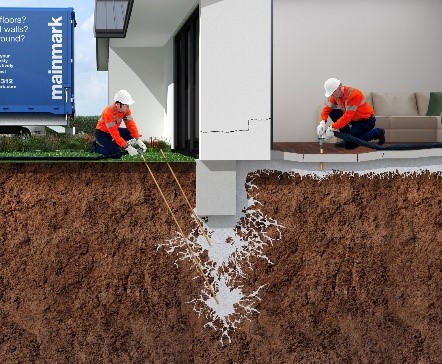
Mainmark gives advice about why building foundations sink and the advanced repair solutions now available
Foundation subsidence is expected to affect as many as one in five homes in England and Wales in the coming years and has cost the UK economy billions of pounds, making it the most damaging geo-hazard in Britain today.[1]
Building foundations can sink in response to changes in the ground or movement of the soil that the foundations and footings rest upon. There are a number of reasons why this occurs.
If the ground beneath a building subsides, an expert should be contacted to assess any damage to the building or soils underlying the building.
Traditionally, repair methods for subsidence related issues were costly and invasive, causing financial and physical disruption. Nowadays, however, there is a range of advanced solutions available from specialists in ground engineering such as those at Mainmark. Mainmark can repair the ground beneath a building using quick, non-invasive and cost-effective methods, ensuring minimal disruption to the property and occupants, and helping to reduce the financial burden.
What causes sinking foundations?
If the ground beneath a building begins to subside, large cracks in the walls, or gaps between the skirting and floors usually develop, indicating that the structure is moving or sinking. This can happen for a number of reasons and can occur across specific areas, large or small, over a long period of time, or, as an immediate reaction to nearby activity or natural events. There are many different factors that can cause the ground beneath a building to subside and these include:
- Renovations or nearby construction – local construction work may change the condition of the ground, particularly if excavation is taking place. Often, a poorly supported excavation can allow nearby soil to slip, causing adjoining foundation ground and footings to sink. Heavy traffic and the vibration of machinery can also move or displace the soil.
- Different footing systems – these can be found in very old buildings, or in homes with extensions or alterations. For buildings built on clay soils (this soil will not change its volume unless the water content changes), generally speaking, deeper footings move less seasonally than shallow footings. An addition or extension alongside an existing home may settle differently to the original building, with most of the settlement of new footings typically occurring in the first five years after construction.
- Water– As water saturates the ground, soil conditions can change. This may be a result of washaways from broken pipes, poorly compacted fill or sloping foundations, causing water to pool, weather events or even seasonal fluctuations in water level. Clay soils can swell when saturated and shrink when dehydrated.
- Tree root – shrubs and roots can also cause problems for house footings particularly if they are close to the property foundations. Property owners should consider the height of the tree, the number of trees close to the property, the root intrusion area, and the soil classification on the site to ensure the risk of damage is reduced.[2]
Different types of soil can also impact the structural integrity of the building, for example, gravel and stony ground is highly likely to collapse or move when nearby ground is excavated, causing foundations to shift and subside. Sandy soils are more easily disrupted by water, as the finer particles are washed out of the soil causing a bridging action between the larger soil particles to collapse. As a result of this, the building above can subside.
To repair foundation subsidence, specialist help is required from experts such as Mainmark who use their advanced solution, Teretek® – a proprietary engineered resin that is a cost-effective, quick and non-invasive solution injected into the foundation soils beneath a structure’s footings.
Smart solutions
Mainmark’s Teretek® proprietary engineered resin is a two-in-one solution that can improve ground bearing capacity and re-level structures, with minimal intrusion and at a significantly lower cost than traditional underpinning repair methods.
The process of using Teretek® is likened to key-hole surgery because it is injected through very small tubes into the ground beneath the foundation in a controlled manner, to fill the voids and strengthen the ground that has subsided, subsequently helping to raise the building back to level. Mainmark’s repair method is also an ideal solution for filling voids and re-establishing strength to weak ground and can be applied to re-support most above-ground structures from, houses and commercial buildings, to moving concrete slabs in driveways, garages or parking areas.
As subsidence continues to become one of the biggest problems affecting buildings in Britain today, it is critical that property owners are aware of the advanced solutions now available, helping to effectively repair the ground to ensure the property stands on stable foundations for many years to come.
For more information about the solutions required to repair the sinking foundations of a building, please visit, www.mainmark.com/uk
[1] https://mainmark.com/uk/residential/foundation-subsidence/
[2]https://www.buildingconservation.com/articles/buildclay/buildclay.htm



